|
My United States Paper Money Collection |

|
|
One Dollar | Two Dollar | Five Dollar | Ten Dollar | Twenty Dollar | Fifty Dollar | Hundred Dollar | Miscellaneous
|
Fifty Dollar Bills |
|
Series 1913 Fifty Dollar Gold Certificate

 
Once redeemable for gold on demand, these large notes were produced from 1906 to 1922. The obverse of the Series 1913 $50 Gold Certificate features a portrait of President Ulysses S Grant and the reverse is a bright orange-gold color as a reminder that this note was redeemable for gold. The Gold Reserve Act of 1933 made these illegal to own, but the restrictions were lifted in 1964, making them possible to own once again.
The obverse of this note reads, "THIS CERTIFIES THAT THERE HAVE BEEN DESPOSITED IN THE TREASURY OF THE UNITED STATES OF AMERICA FIFTY DOLLARS IN GOLD COIN PAYABLE TO THE BEARER ON DEMAND" and also bears the text, "ACT OF JULY 12, 1882."
The reverse simply states, "UNITED STATES OF AMERICA FIFTY DOLLARS IN GOLD COIN."
|
|
Series 1914 Fifty Federal Reserve Note (Blue Seal)




Large Size Federal Reserve Notes were printed from 1878 to 1923 in the United States as part of its circulation of paper currency and were initially redeemable in the same face value of silver dollar coins, and later in raw silver bullion. Issued in the large size of 7-3/8 by 3-1/8 inches (about 50 percent larger than today’s paper currency), the design of the Series 1914 $50 Federal Reserve Note reflects a time in American history when currency was not just money but also a work of art. The obverse of the Series 1914 $50 Federal Reserve Note features a portrait of President Ulysses S Grant. The first of these Series 1914 notes had distinctive red Treasury seals at the right (later notes in the same Series had blue seals, such as the example shown here), as well as a black seal on the left bearing both the district number (1-12) and the district letter (A-L) of the Federal Reserve Bank of issuance (the twelve Federal Reserve Districts were Boston, New York, Philadelphia, Cleveland, Richmond, Atlanta, Chicago, St. Louis, Minneapolis, Kansas City, Dallas, and San Francisco). This regional seal is a design facet unique to Federal Reserve Notes, because almost all other types of notes were issued directly by the U.S. Treasury. The obverse also bears the phrases, "FEDERAL RESERVE NOTE", "AUTHORIZED BY FEDERAL RESERVE ACT OF DECEMBER 23, 1913" and "THE UNITED STATES OF AMERICA WILL PAY TO THE BEARER ON DEMAND FIFTY DOLLARS."
Note that, while all Series 1914 $100 Federal Reserve Notes were printed in Washington DC, they were issued for all twelve Federal Reserve districts (Boston, New York, Philadelphia, Cleveland, Richmond, Atlanta, Chicago, St. Louis, Minneapolis, Kansas City, Dallas, and San Francisco). The black seal on this particular note indicates that it was issued for the Federal Reserve Bank of Cleveland, Ohio.
The reverse depcits a femal figure representing Panama standing on land between the Atlantic and Pacific Oceans. It also bears the rather lengthy redemption clause that states, "THIS NOTE IS RECEIVABLE BY ALL NATIONAL AND MEMBER BANKS AND FEDERAL RESERVE BANKS AND FOR ALL TAXES, CUSTOMS AND OTHER PUBLIC DUES. IT IS REDEEMABLE IN GOLD ON DEMAND AT THE TREASURY DEPARTMENT OF THE UNITED STATES IN THE CITY OF WASHINGTON, DISTRICT OF COLUMBIA OR IN GOLD OR LAWFUL MONEY AT ANY FEDERAL RESERVE BANK."
|
|
Series 1922 Fifty Dollar Gold Certificate
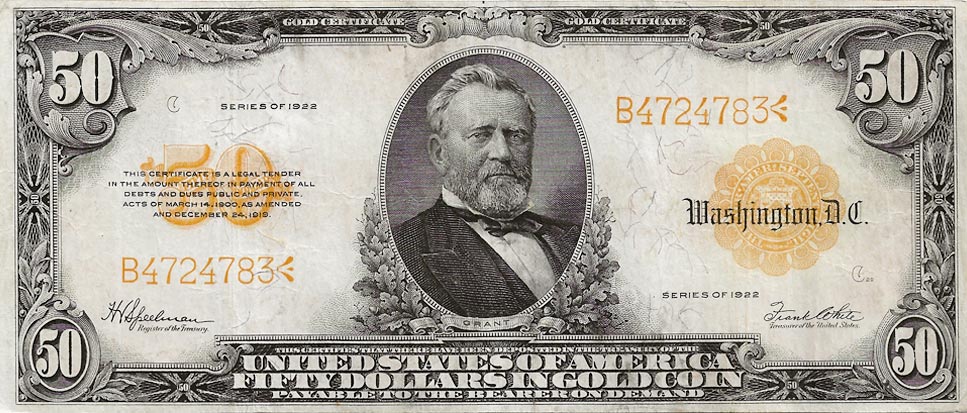
 
Once redeemable for gold on demand, these large notes were produced from 1906 to 1922. The Series 1922 $50 Gold Certificate is the last large-size $20 Gold Certificates issued before being replaced with the small-sized notes in 1928. The obverse features a portrait of President Ulysses S Grant and the reverse is a bright orange-gold color as a reminder that this note was redeemable for gold. The Gold Reserve Act of 1933 made these illegal to own, but the restrictions were lifted in 1964, making them possible to own once again.
The obverse of this note reads, "THIS CERTIFIES THAT THERE HAVE BEEN DESPOSITED IN THE TREASURY OF THE UNITED STATES OF AMERICA FIFTY DOLLARS IN GOLD COIN PAYABLE TO THE BEARER ON DEMAND" and also bears the text, "THIS CERTIFICIATE IS A LEGAL TENDER IN THE AMOUNT THEREOF IN PAYMENT OF ALL DEBTS AND DUES PUBLIC AND PRIVATE. ACTS OF MARCH 14, 1900, AS AMENDED AND DECEMBER 24, 1919." The reverse simply states, "UNITED STATES OF AMERICA FIFTY DOLLARS IN GOLD COIN."
|
|
Series 1928 Fifty Dollar Gold Certificate
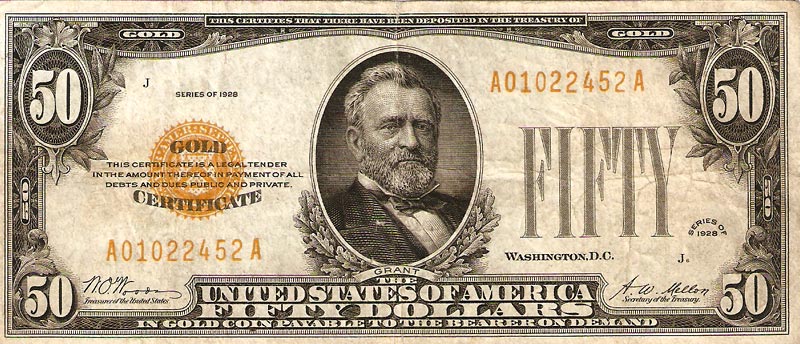
 
Once redeemable for gold on demand, U.S. Gold Certificates are among the most sought after of all paper currency. Rendered obsolete by Franklin Roosevelt’s Gold Recall Order of 1933, the Series 1928 $50 Gold Certificate features an engraved portrait of President Ulysses S Grant and bears a distinctive gold Treasury seal and serial numbers. The obverse bears the obligation "THIS CERTIFIES THAT THERE HAVE BEEN DEPOSITED IN THE TREASURY OF THE UNITED STATES OF AMERICA FIFTY DOLLARS IN GOLD COIN PAYABLE TO THE BEARER ON DEMAND" as well as the redemption clause stating, "THIS CERTIFICATE IS A LEGAL TENDER IN THE AMOUNT THEREOF IN PAYMENT OF ALL DEBTS AND DUES PUBLIC AND PRIVATE."
The green reverse features an image of the U.S. Capitol.
|
|
Series 1928A Fifty Dollar Federal Reserve Note
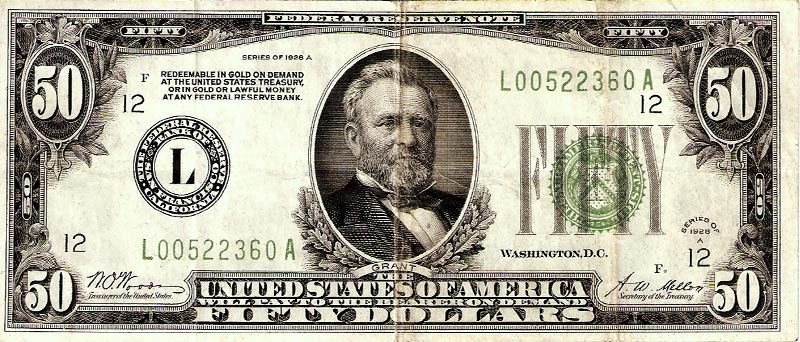
 
The obverse of the Series 1928A $50 Federal Reserve Note features a portrait of Ulysses S Grant, while the reverse displays the U.S. Capitol. As with all Federal Reserve Notes, the obverse features a green Treasury Seal on the right and a special black seal on the left bearing the identity of the Federal Reserve Bank of issuance. Since the issuance of these notes predated the Gold Reserve Act of 1933, the obligation clause on the obverse reads, "REDEEMABLE IN GOLD ON DEMAND AT THE UNITED STATES TREASURY, OR IN GOLD OR LAWFUL MONEY AT ANY FEDERAL RESERVE BANK." Also printed on the front are the phrases, "FEDERAL RESERVE NOTE" and "THE UNITED STATES OF AMERICA WILL PAY TO THE BEARER ON DEMAND FIFTY DOLLARS."
Note that, while all Series 1928 $50 Federal Reserve Notes were printed in Washington DC, they were issued for all twelve Federal Reserve districts (Boston, New York, Philadelphia, Cleveland, Richmond, Atlanta, Chicago, St. Louis, Minneapolis, Kansas City, Dallas, and San Francisco). The black seal on this particular note indicates that it was issued for the Federal Reserve Bank of San Francisco, California. Unlike previous Federal Reserve Notes that used both the district number and district letter to represent the specific bank of issuance, the Series 1928 and 1928A versions of this note used just the distict number (1-12) to represent the specific bank of issuance. Later notes used the district letter (A-L) instead.
|
|
Series 1929 Fifty Dollar Federal Reserve Bank Note (New York, New York)
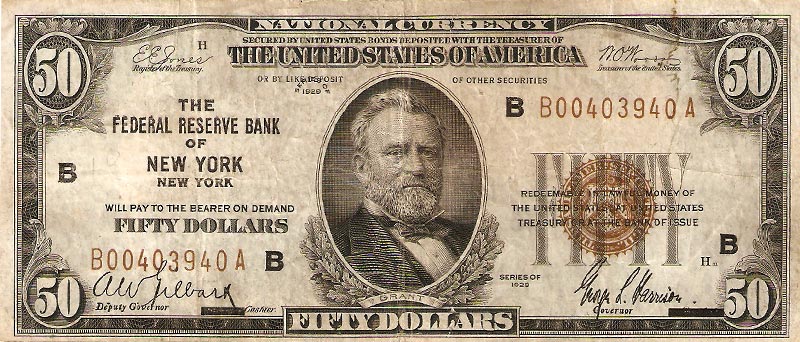
 
Series 1929 $50 National Currency Notes have a distinctive brown seal and were issued in two different varieties. The first type (which are properly called "National Currency Bank Notes") were issued by individual local banks from every state. The second type (which are more properly known as "Federal Reserve Bank Notes") were issued by all twelve Federal Reserve districts (Boston, New York, Philadelphia, Cleveland, Richmond, Atlanta, Chicago, St. Louis, Minneapolis, Kansas City, Dallas, and San Francisco).
This particular note is a Federal Reserve Bank Note issued by the Federal Reserve Bank of New York, New York. The obverse bears the legend, "NATIONAL CURRENCY SECURED BY UNITED STATES BONDS DEPOSITED WITH THE TREASURER OF THE UNITED STATES OF AMERICA OR BY LIKE DEPOSIT OF OTHER SECURITIES" and a redemption clause that reads, "REDEEMABLE IN LAWFUL MONEY OF THE UNITED STATES, AT UNITED STATES TREASURY OR AT THE BANK OF ISSUE." The obligation clause reads, "THE FEDERAL RESERVE BANK OF NEW YORK NEW YORK WILL PAY TO THE BEARER ON DEMAND FIFTY DOLLARS." The reverse features an image of the Capitol Building.
|
|
Series 1934 Fifty Dollar Federal Reserve Note
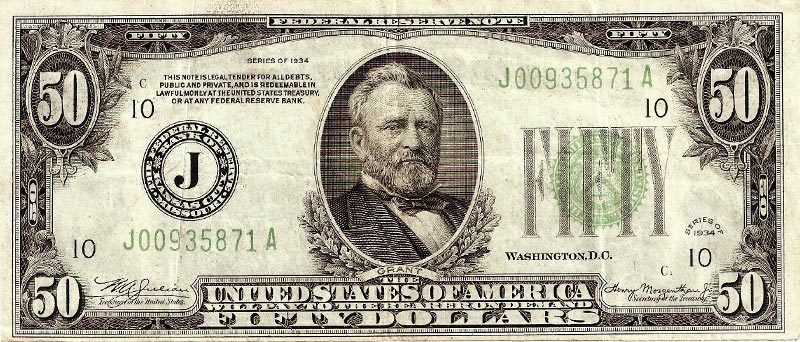
 
The obverse of the Series 1934 $50 Federal Reserve Note features a portrait of Ulysses S Grant, while the reverse displays the U.S. Capitol. As with all Federal Reserve Notes, the obverse features a green Treasury Seal on the right and a special black seal on the left bearing the identity of the Federal Reserve Bank of issuance. Since these notes were issued after the Gold Reserve Act of 1933, the obligation clause on the obverse reads, "THIS NOTE IS LEGAL TENDER FOR ALL DEBTS, PUBLIC AND PRIVATE, AND IS REDEEMABLE IN LAWFUL MONEY AT THE UNITED STATES TREASURY, OR AT ANY FEDERAL RESERVE BANK." Also printed on the front are the phrases, "FEDERAL RESERVE NOTE" and "THE UNITED STATES OF AMERICA FIFTY DOLLARS."
|
|
Series 1950B Fifty Dollar Federal Reserve Note

 
The Series 1950 $50 Federal Reserve Note is very similar to the 1934 version, except that the green Treasury Seal on the right is a little darker and smaller, the words "WASHINGTON, D.C." now appear above the seal instead of below it, and the font of the obligation clause has been shrunk to fit on three lines instead of four. The obligation clause reads, "THIS NOTE IS LEGAL TENDER FOR ALL DEBTS, PUBLIC AND PRIVATE, AND IS REDEEMABLE IN LAWFUL MONEY AT THE UNITED STATES TREASURY, OR AT ANY FEDERAL RESERVE BANK." The redemption clause on the obverse states, "THE UNITED STATES OF AMERICA WILL PAY TO THE BEARER ON DEMAND FIFTY DOLLARS."
|
|
Series 1963A Fifty Dollar Federal Reserve Note
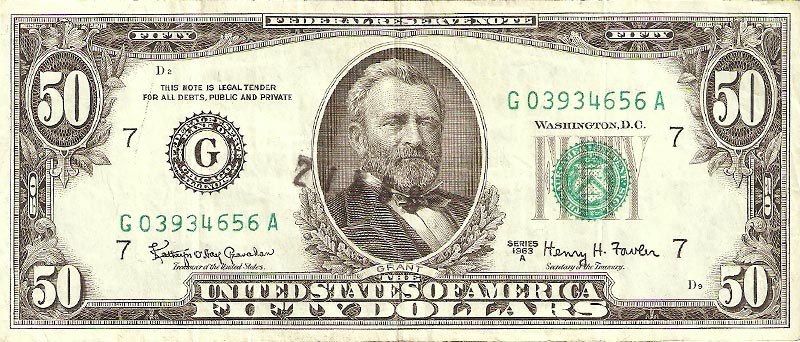
 
The Series 1963 $50 Federal Reserve Note is very similar to the 1950 version, except that obligation clause on the obverse simply reads, "THIS NOTE IS LEGAL TENDER FOR ALL DEBTS, PUBLIC AND PRIVATE" and the redemption clause has been removed completely to indicate the fact that U.S. currency was now considered fiat money, unbacked by any physical asset.. Also, the words "IN GOD WE TRUST" have been added to the reverse.
|
|
One Dollar | Two Dollar | Five Dollar | Ten Dollar | Twenty Dollar | Fifty Dollar | Hundred Dollar | Miscellaneous
|
|
|